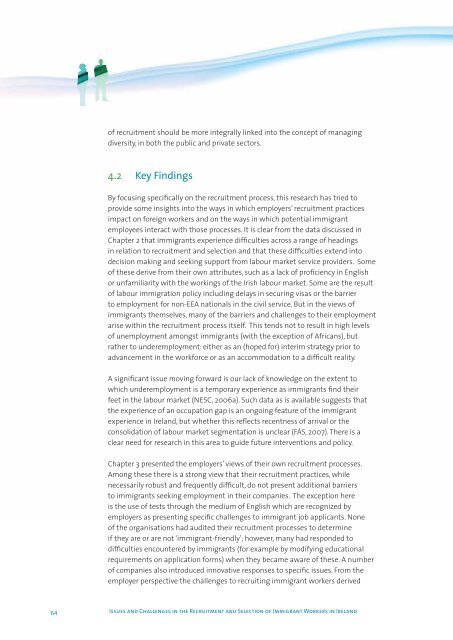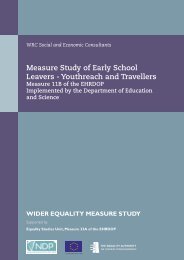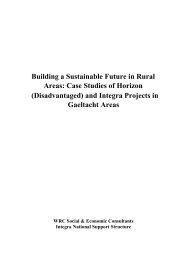Issues and Challenges in the Recruitment and Selection of ...
Issues and Challenges in the Recruitment and Selection of ...
Issues and Challenges in the Recruitment and Selection of ...
Create successful ePaper yourself
Turn your PDF publications into a flip-book with our unique Google optimized e-Paper software.
<strong>of</strong> recruitment should be more <strong>in</strong>tegrally l<strong>in</strong>ked <strong>in</strong>to <strong>the</strong> concept <strong>of</strong> manag<strong>in</strong>gdiversity, <strong>in</strong> both <strong>the</strong> public <strong>and</strong> private sectors.4.2 Key F<strong>in</strong>d<strong>in</strong>gsBy focus<strong>in</strong>g specifically on <strong>the</strong> recruitment process, this research has tried toprovide some <strong>in</strong>sights <strong>in</strong>to <strong>the</strong> ways <strong>in</strong> which employers’ recruitment practicesimpact on foreign workers <strong>and</strong> on <strong>the</strong> ways <strong>in</strong> which potential immigrantemployees <strong>in</strong>teract with those processes. It is clear from <strong>the</strong> data discussed <strong>in</strong>Chapter 2 that immigrants experience difficulties across a range <strong>of</strong> head<strong>in</strong>gs<strong>in</strong> relation to recruitment <strong>and</strong> selection <strong>and</strong> that <strong>the</strong>se difficulties extend <strong>in</strong>todecision mak<strong>in</strong>g <strong>and</strong> seek<strong>in</strong>g support from labour market service providers. Some<strong>of</strong> <strong>the</strong>se derive from <strong>the</strong>ir own attributes, such as a lack <strong>of</strong> pr<strong>of</strong>iciency <strong>in</strong> Englishor unfamiliarity with <strong>the</strong> work<strong>in</strong>gs <strong>of</strong> <strong>the</strong> Irish labour market. Some are <strong>the</strong> result<strong>of</strong> labour immigration policy <strong>in</strong>clud<strong>in</strong>g delays <strong>in</strong> secur<strong>in</strong>g visas or <strong>the</strong> barrierto employment for non-EEA nationals <strong>in</strong> <strong>the</strong> civil service. But <strong>in</strong> <strong>the</strong> views <strong>of</strong>immigrants <strong>the</strong>mselves, many <strong>of</strong> <strong>the</strong> barriers <strong>and</strong> challenges to <strong>the</strong>ir employmentarise with<strong>in</strong> <strong>the</strong> recruitment process itself. This tends not to result <strong>in</strong> high levels<strong>of</strong> unemployment amongst immigrants (with <strong>the</strong> exception <strong>of</strong> Africans), butra<strong>the</strong>r to underemployment: ei<strong>the</strong>r as an (hoped for) <strong>in</strong>terim strategy prior toadvancement <strong>in</strong> <strong>the</strong> workforce or as an accommodation to a difficult reality.A significant issue mov<strong>in</strong>g forward is our lack <strong>of</strong> knowledge on <strong>the</strong> extent towhich underemployment is a temporary experience as immigrants f<strong>in</strong>d <strong>the</strong>irfeet <strong>in</strong> <strong>the</strong> labour market (NESC, 2006a). Such data as is available suggests that<strong>the</strong> experience <strong>of</strong> an occupation gap is an ongo<strong>in</strong>g feature <strong>of</strong> <strong>the</strong> immigrantexperience <strong>in</strong> Irel<strong>and</strong>, but whe<strong>the</strong>r this reflects recentness <strong>of</strong> arrival or <strong>the</strong>consolidation <strong>of</strong> labour market segmentation is unclear (FÁS, 2007). There is aclear need for research <strong>in</strong> this area to guide future <strong>in</strong>terventions <strong>and</strong> policy.Chapter 3 presented <strong>the</strong> employers’ views <strong>of</strong> <strong>the</strong>ir own recruitment processes.Among <strong>the</strong>se <strong>the</strong>re is a strong view that <strong>the</strong>ir recruitment practices, whilenecessarily robust <strong>and</strong> frequently difficult, do not present additional barriersto immigrants seek<strong>in</strong>g employment <strong>in</strong> <strong>the</strong>ir companies. The exception hereis <strong>the</strong> use <strong>of</strong> tests through <strong>the</strong> medium <strong>of</strong> English which are recognized byemployers as present<strong>in</strong>g specific challenges to immigrant job applicants. None<strong>of</strong> <strong>the</strong> organisations had audited <strong>the</strong>ir recruitment processes to determ<strong>in</strong>eif <strong>the</strong>y are or are not ‘immigrant-friendly’; however, many had responded todifficulties encountered by immigrants (for example by modify<strong>in</strong>g educationalrequirements on application forms) when <strong>the</strong>y became aware <strong>of</strong> <strong>the</strong>se. A number<strong>of</strong> companies also <strong>in</strong>troduced <strong>in</strong>novative responses to specific issues. From <strong>the</strong>employer perspective <strong>the</strong> challenges to recruit<strong>in</strong>g immigrant workers derived64<strong>Issues</strong> <strong>and</strong> <strong>Challenges</strong> <strong>in</strong> <strong>the</strong> <strong>Recruitment</strong> <strong>and</strong> <strong>Selection</strong> <strong>of</strong> Immigrant Workers <strong>in</strong> Irel<strong>and</strong>




